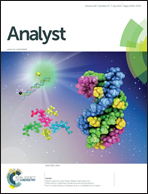Rapid, randomized development of genetically encoded FRET sensors for small molecules†
Abstract
Imaging small molecules in living cells can be achieved with genetically encoded fluorescent reporters. The most common sensors emit a signal generated by Förster resonance energy transfer (FRET), which occurs when two fluorescent proteins that flank a sensor protein are moved into close proximity. This movement occurs when the sensor protein binds a ligand of interest. The structural requirements for creating this type of sensor are complex. Typically, novel sensors are developed by testing different linkers between the fluorescent and the binding proteins, or by rationally modifying the binding protein based on its three-dimensional structure, when the structure is available. These procedures take up to months, and are tedious and inefficient. Here, we developed a generally applicable method that starts with a ligand-binding protein of choice and generates a library with thousands of candidate sensors with random asymmetric truncations and mutations in the binding moiety. We demonstrated, with examples of sensors for glucose, pyruvate, and thiamine, that our method allowed identification of novel sensors with ample FRET responses and a wide range of affinities, within about two weeks. Our method does not depend on structural information, it is flexible with respect to the FRET pair, and it substantially enhances the speed of FRET sensor development.


 Please wait while we load your content...
Please wait while we load your content...